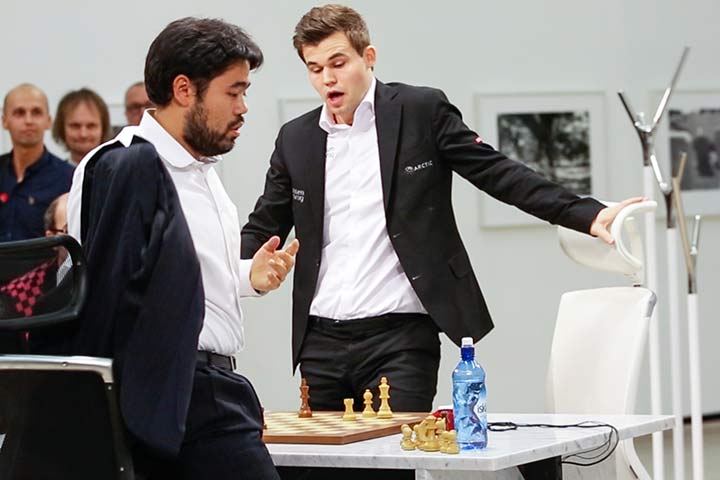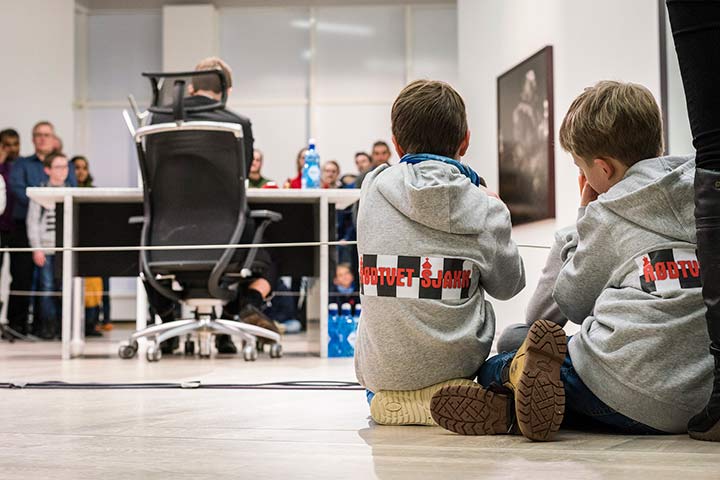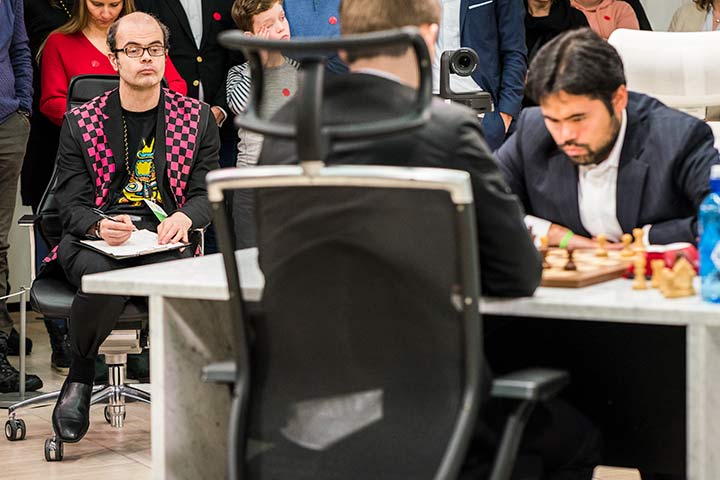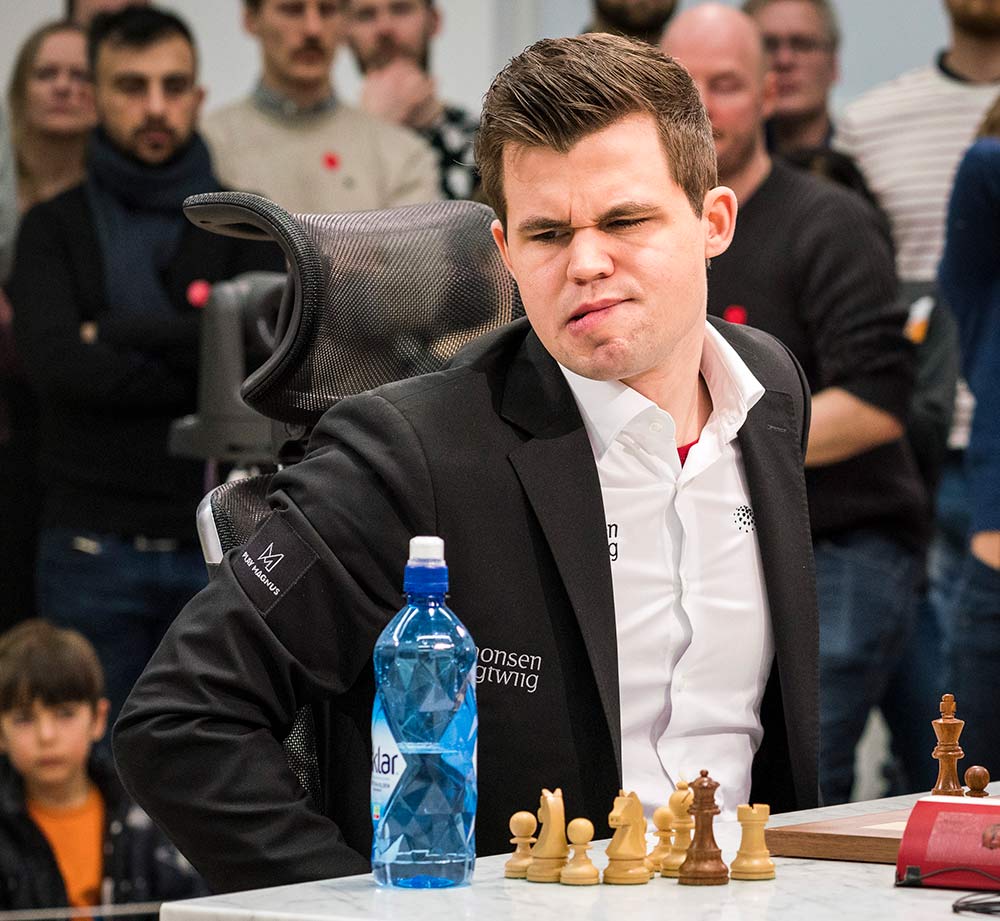


Chess News







After losing game seven, and trailing 9 : 5, Hikaru Nakamura was in a must win situation if he had any hope to close the gap in the blitz session, where wins only count for one point. But as game eight unfolded, that looked increasingly unlikely. Magnus was in the driver's seat and commentators Yasser Seirawan and Anna Rudolf were predicting almost certain defeat for the American.
Yet, as the second time control ticked by, the players traded down into a rook-and-bishop-versus-rook ending which is notoriously difficult to win, even with ample time on the clock. Carlsen was trying to do it with under two minutes on his. Nakamura kept moving quickly, until at some point everyone thought that surely Magnus would give up and offer a draw. There was just no time left to keep playing. Amazingly he continued moving and as his clock approached zero both players heartrates spiked — Magnus' pulse was over 100, a rare occurrance in this match.

The playing hall has limited standing room, necessitating a queue | Photo: Lennart Ootes / frchess.com
The final position is a theoretical draw, but also came 50 moves after the last pawn move or capture, such that Carlsen could have simply claimed a draw and been leading the match 10 : 6 heading into the blitz. Then, he would have needed just 2½ in the eight game blitz match to ensure overall victory. Instead his margin remains at two points, which gives Nakamura real chances to catch up in the blitz.
Position 558 in Chess960 — Play through the moves on the live diagram!
1.f4 f6 2.e4 e5
Both players have abandoned any kind of hypermodern approach — when there is no theory, or you don't know the theory, you can't go for the equivalent of a Gruenfeld, there is simply no choice but to play classically as that is the most reliable style. Put pawns in the centre, and pieces behind them.
3.fxe5 fxe5 4.Nbc3 Ne6 5.Nd5 It's not clear to me what White wanted to acheive by this knight leap, except if he wanted c3 and
d4 (and if so, then why his 4th?) (5.Bc4 was a good 'classical' move.)
5...c6 6.N5e3 d6 7.g3 Nd7 The initial position used this time was quite an equal one, and White has played a bit lackadaisically, so maybe Black is more comfortable already. 8.Bh3 O-O-O
9.d3 Kb8 =/+ 10.Qf2 Ndc5 11.Nc3 Nd4 Thinking of ...d5. 12.Ne2 (12.O-O-O g6 doesn't really help; here Black probably changes tack and plays without ...d5.) 12...Nxe2+ 13.Qxe2 d5 14.exd5 cxd5 15.Ng4 (15. O-O-O could have been a good try with the centre opening up, though Black is better after say Qa4 !? =/+)
15...d4 16.Bg2 Bd6 17.h3 Rc8 18.Bf2 Trying to evacuate the king, which in this case is quite a creative defence! (18.Nf2 was consistent, but too slow: Qb5 with the idea of ...Na4 forces major concessions and Black is close to winning.) 18...h5 19.Nh2 e4! (19... Qb5 20. O-O !! is the point, and while Black's position is still more pleasant he has no real attack as such. 20.O-O

And this was during the game he won! | Photo: Lennart Ootes / frchess.com
Nakamura really did need to win this game to keep the excitment factor high in the final day of the match, but nobody would have predicted that he would score the point in the manner that transpired!
8.O-O-O
19...O-O-O! Black has played the last five moves perfectly and it seems that things are gradually becoming less clear.

Carlsen loses on time in a strange game he'll be eager to forget! | Photo: Lennart Ootes / frchess.com
GM Jonathan Tisdall, writing on the official site called it "a miracle":
"Watching this, my only thought was that I had witnessed the flip side of the secret of Carlsen’s success — a will to win so extreme that it just could not be physically disarmed...To me it looked like a man in the grip of his basic urge."
Live commentary by GM Yasser Seirawan and IM Anna Rudolf

A very pretty scene outside the playing venue | Photo: Lennart Ootes / frchess.com
So, eight more games to play, at a time control of 10 minutes plus 5 seconds per move, and this time the players will receive just half a point for a draw and one point for a win. The "short rapid" or "long blitz" games begin at 17:00 CET (11:00 am) start time.